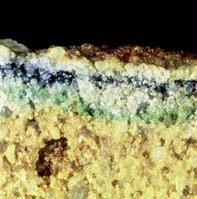BSU Physics Seminar
Today, in physics, we hosted Prof. Nancy Chanover of New Mexico State Astronomy for our departmental seminar. Chanover gave a fascinating talk on her work developing acousto-optical tunable filters (AOTFs) to look for life in exotic terrestrial environments and on Mars.
AOTFs involve the application of an oscillating radio signal to a birefringent crystal. By applying the right frequency to the crystal, the crystal can be made to filter out light of very specific colors. Measuring the filtered light that comes out allows one to measure the colors of a object — is there more red light that filters through than blue, for instance?
One big advantage of these AOTFs is that they can produce spectra of rocks, minerals, anything that is colored, without any moving parts, and no moving parts is a big plus when you send an instrument to another planet.
In her talk, Prof. Chanover discussed her group’s work to develop AOTFs and techniques to analyze the emergent spectra and identify minerals on planets or moons in our solar system. Different minerals can have distinctive colors, and so taking the spectrum of a Mars rock, say, could allow us to identify its composition, without having to vaporize the rock to chemically analyze it.
The same technique could be used to look for Martian life. In some cases, extremophiles on the Earth leave tell-tale coloration in rocks (see figure at left), and so Martian life (if it exists) might do the same. Prof. Chanover’s group is looking for the distinctive spectral signatures of terrestrial biota in hopes of sending an AOTF to Mars and looking for life there, particularly in caves, which might be especially hospitable for life.
As a precursor to exploration of Martian caves, Chanover discussed her work attaching an AOTF to a robot developed by the Jet Propulsion Lab that climbs walls using footpads inspired by geckos, a LEMUR. This project involved several unforeseen challenges — as she said, on one trip, she struggled to say “acousto-optical tunable filter” in Spanish to a dubious Mexican border guard on the way to a field site in Mexico. The life of a planetary scientist.

A computer model of an hexagonal lipid-DNA complex. From https://www.equipes.lps.u-psud.fr/TRESSET/research5.html.
Special biophysics seminar today hosted by my fellow prof. Matt Ferguson and presented by his former postdoc advisor Ralph Nossal on subtle changes in the properties of lipids as a function of temperature.
Dr. Nossal reviewed research by himself, Dr. Norman Gershfeld, and others going back to the 40s showing how the physical properties of lipids, including surface pressure and diffusivity, depend sensitively on their temperatures. Diffusivity, for example, for many biogenic and synthetic lipid solutions peak at very specific temperatures.
What’s so special about those temperatures? Nossal pointed out that they correspond very nearly to the body temperatures of the organisms in which the lipids are found. So this subtle behavior could be the result of biological tuning of the lipids to optimize their chemical behavior in their host organisms.

The density of Bose-Einstein condensates, exhibiting interference of their quantum mechanical wave functions. From https://sites.google.com/site/bigelowcatgroup/bec.
BSU’s Materials Science and Engineering Dept had a guest today from the University of Rochester, Prof. Nick Bigelow. Prof. Bigelow spoke this afternoon in the physics department about his experiments producing Bose-Einstein condensates in his optics lab. He did a great job of explaining their subtle physics at a level that our undergrads and even our lowly astronomers could understand.
In his lab, he uses lasers to cool small pockets of low-density rubidium gas to a Bose-Einstein condensation state and then spins up a torus of the gas with variously polarized laser beams. The quantum mechanical wave function describing the gas torus must then have an integer number of oscillations over its circumference.
By putting the spinning torus of gas into contact with other Bose-Einstein condensates with known wave functions (either spinning or not), Bigelow’s group can demonstrate the effects of interference between the quantum mechanical wave functions for the two condensates. The figure at top left shows the clouds of gas that form, exhibiting graceful density enhancements (warmer colors) that result from interference of the wavefunctions.
As lucid and compelling as Bigelow’s talk was, it highlighted again for me how strange and counter-intuitive quantum mechanical systems are. It reminded me of Richard Feynman‘s famous quote, “If you think you understand quantum mechanics, you don’t understand quantum mechanics” (which, I just learned, is not a Feynman quote at all, but a paraphrase of a Bohr quote).
